Attached files
| file | filename |
|---|---|
| EX-99.1 - EXHIBIT 99.1 - COVANTA HOLDING CORP | exhibit991q419.htm |
| 8-K - 8-K - COVANTA HOLDING CORP | form8-kq419earnings.htm |

Fourth Quarter 2019 Earnings Conference Call NYSE: CVA February 20, 2020

Cautionary Statements All information included in this earnings presentation is based on continuing operations, unless otherwise noted. Forward-Looking Statements Certain statements in this press release may constitute “forward-looking” statements as defined in Section 27A of the Securities Act of 1933, as amended (the “Securities Act”), Section 21E of the Securities Exchange Act of 1934 (the “Exchange Act”), the Private Securities Litigation Reform Act of 1995 (the “PSLRA”) or in releases made by the Securities and Exchange Commission (“SEC”), all as may be amended from time to time. Such forward-looking statements involve known and unknown risks, uncertainties and other important factors that could cause the actual results, performance or achievements of Covanta Holding Corporation and its subsidiaries (“Covanta”) or industry results, to differ materially from any future results, performance or achievements expressed or implied by such forward-looking statements. Statements that are not historical fact are forward-looking statements. Forward-looking statements can be identified by, among other things, the use of forward-looking language, such as the words “plan,” “believe,” “expect,” “anticipate,” “intend,” “estimate,” “project,” “may,” “will,” “would,” “could,” “should,” “seeks,” or “scheduled to,” or other similar words, or the negative of these terms or other variations of these terms or comparable language, or by discussion of strategy or intentions. These cautionary statements are being made pursuant to the Securities Act, the Exchange Act and the PSLRA with the intention of obtaining the benefits of the “safe harbor” provisions of such laws. Covanta cautions investors that any forward-looking statements made by Covanta are not guarantees or indicative of future performance. Important assumptions and other important factors, risks and uncertainties that could cause actual results to differ materially from those forward-looking statements with respect to Covanta include, but are not limited to: the risks and uncertainties affecting Covanta's business described in periodic securities filings by Covanta with the SEC. Important factors, risks, and uncertainties that could cause actual results of Covanta and the JV to differ materially from those forward-looking statements include, but are not limited to: seasonal or long-term fluctuations in the prices of energy, waste disposal, scrap metal and commodities, and Covanta's ability to renew or replace expiring contracts at comparable prices and with other acceptable terms; adoption of new laws and regulations in the United States and abroad, including energy laws, tax laws, environmental laws, labor laws and healthcare laws; advances in technology; difficulties in the operation of our facilities, including fuel supply and energy delivery interruptions, failure to obtain regulatory approvals, equipment failures, labor disputes and work stoppages, and weather interference and catastrophic events; failure to maintain historical performance levels at Covanta's facilities and Covanta's ability to retain the rights to operate facilities Covanta does not own; Covanta's and the joint ventures ability to avoid adverse publicity or reputational damage relating to its business; difficulties in the financing, development and construction of new projects and expansions, including increased construction costs and delays; Covanta's ability to realize the benefits of long-term business development and bear the costs of business development over time; Covanta's ability to utilize net operating loss carryforwards; limits of insurance coverage; Covanta's ability to avoid defaults under its long-term contracts; performance of third parties under its contracts and such third parties' observance of laws and regulations; concentration of suppliers and customers; geographic concentration of facilities; increased competitiveness in the energy and waste industries; changes in foreign currency exchange rates; limitations imposed by Covanta's existing indebtedness and its ability to perform its financial obligations and guarantees and to refinance its existing indebtedness; exposure to counterparty credit risk and instability of financial institutions in connection with financing transactions; the scalability of its business; restrictions in its certificate of incorporation and debt documents regarding strategic alternatives; failures of disclosure controls and procedures and internal controls over financial reporting; Covanta's and the joint ventures ability to attract and retain talented people; general economic conditions in the United States and abroad, including the availability of credit and debt financing; and other risks and uncertainties affecting Covanta's businesses described periodic securities filings by Covanta with the SEC. Although Covanta believes that its plans, cost estimates, returns on investments, intentions and expectations reflected in or suggested by such forward-looking statements are reasonable, actual results could differ materially from a projection or assumption in any forward-looking statements. Covanta's and the joint ventures future financial condition and results of operations, as well as any forward-looking statements, are subject to change and to inherent risks and uncertainties. The forward-looking statements contained in this press release are made only as of the date hereof and Covanta does not have, or undertake, any obligation to update or revise any forward-looking statements whether as a result of new information, subsequent events or otherwise, unless otherwise required by law. Note: All estimates with respect to 2020 and future periods are as of February 20, 2020. Covanta does not have or undertake any obligation to update or revise any forward-looking statements whether as a result of new information, subsequent events or otherwise, unless otherwise required by law. Discussion of Non-GAAP Financial Measures We use a number of different financial measures, both United States generally accepted accounting principles (“GAAP”) and non-GAAP, in assessing the overall performance of our business. To supplement our assessment of results prepared in accordance with GAAP, we use the measures of Adjusted EBITDA and Free Cash Flow which are non-GAAP measures as defined by the Securities and Exchange Commission. The non-GAAP financial measures of Adjusted EBITDA and Free Cash Flow as described below, and used in this release, are not intended as a substitute or as an alternative to net income or cash flow provided by operating activities as indicators of our performance or liquidity or any other measures of performance or liquidity derived in accordance with GAAP. In addition, our non-GAAP financial measures may be different from non-GAAP measures used by other companies, limiting their usefulness for comparison purposes. The presentations of Adjusted EBITDA and Free Cash Flow are intended to enhance the usefulness of our financial information by providing measures which management internally use to assess and evaluate the overall performance of its business and those of possible acquisition or divestiture candidates, and highlight trends in the overall business. Note: Throughout this presentation, certain amounts may not total due to rounding. 2 February 20, 2020

2019 Financial Summary (Unaudited) (in millions) FY 2019 FY 2018 FY 2020 Guidance Revenue $1,870 $1,868 Net income $10 $152 Adjusted EBITDA $428 $457 $415 - $445 Net cash provided by operating activities $226 $238 Free Cash Flow $140 $100 $100 - $140 3 February 20, 2020
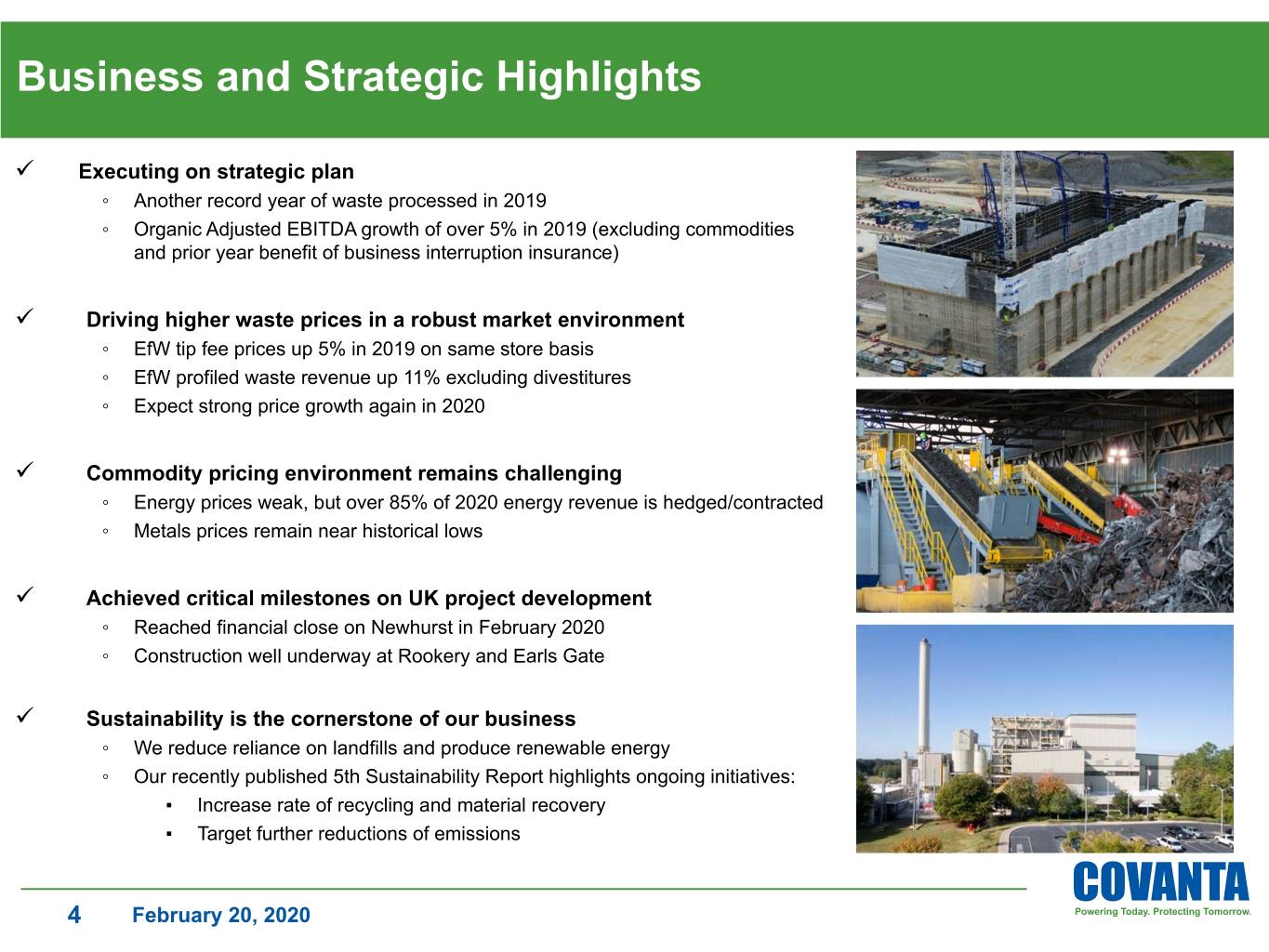
Business and Strategic Highlights ü Executing on strategic plan ◦ Another record year of waste processed in 2019 ◦ Organic Adjusted EBITDA growth of over 5% in 2019 (excluding commodities and prior year benefit of business interruption insurance) ü Driving higher waste prices in a robust market environment ◦ EfW tip fee prices up 5% in 2019 on same store basis ◦ EfW profiled waste revenue up 11% excluding divestitures ◦ Expect strong price growth again in 2020 ü Commodity pricing environment remains challenging ◦ Energy prices weak, but over 85% of 2020 energy revenue is hedged/contracted ◦ Metals prices remain near historical lows ü Achieved critical milestones on UK project development ◦ Reached financial close on Newhurst in February 2020 ◦ Construction well underway at Rookery and Earls Gate ü Sustainability is the cornerstone of our business ◦ We reduce reliance on landfills and produce renewable energy ◦ Our recently published 5th Sustainability Report highlights ongoing initiatives: ▪ Increase rate of recycling and material recovery ▪ Target further reductions of emissions 4 February 20, 2020
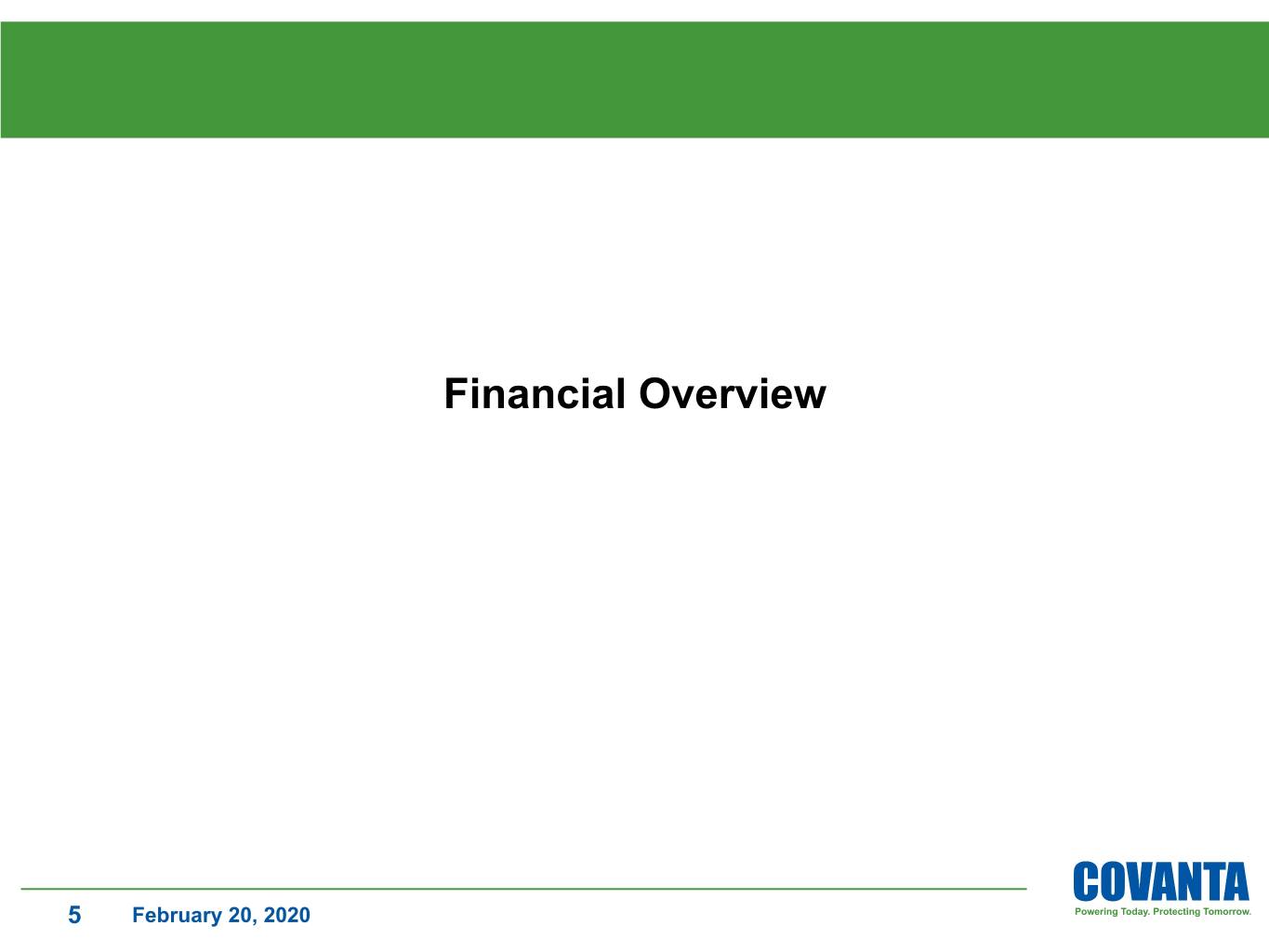
Financial Overview 5 February 20, 2020

Revenue: 2019 vs. 2018 (Unaudited) (1) (2) 1) Includes waste and service revenue, energy and metals volume, metals processing, wholesale energy load serving, and construction activity. 2) Energy price includes capacity payments. 6 February 20, 2020

Adjusted EBITDA: 2019 vs. 2018 (Unaudited) (1) (2) 1) Includes waste and service revenue, energy and metals volume, metals processing, wholesale energy load serving, plant operating costs, construction activity, insurance proceeds, and overhead. 2) Energy price includes capacity payments and RECs. 7 February 20, 2020

Free Cash Flow: 2019 vs. 2018 (Unaudited) (1) 1) Includes capital type expenditures at client owned facilities. 8 February 20, 2020
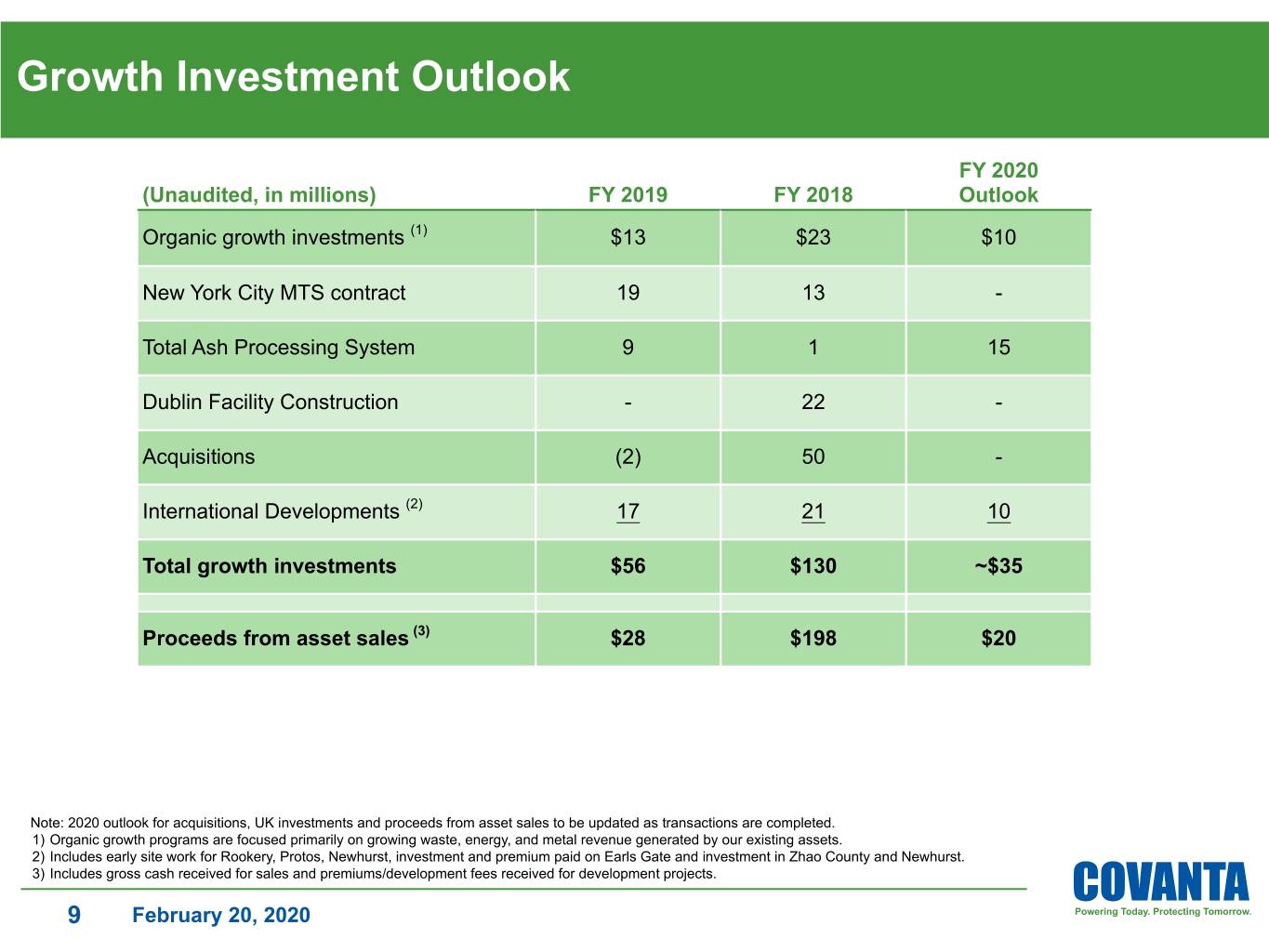
Growth Investment Outlook FY 2020 (Unaudited, in millions) FY 2019 FY 2018 Outlook Organic growth investments (1) $13 $23 $10 New York City MTS contract 19 13 - Total Ash Processing System 9 1 15 Dublin Facility Construction - 22 - Acquisitions (2) 50 - International Developments (2) 17 21 10 Total growth investments $56 $130 ~$35 Proceeds from asset sales (3) $28 $198 $20 Note: 2020 outlook for acquisitions, UK investments and proceeds from asset sales to be updated as transactions are completed. 1) Organic growth programs are focused primarily on growing waste, energy, and metal revenue generated by our existing assets. 2) Includes early site work for Rookery, Protos, Newhurst, investment and premium paid on Earls Gate and investment in Zhao County and Newhurst. 3) Includes gross cash received for sales and premiums/development fees received for development projects. 9 February 20, 2020

Capitalization Summary (Face value; unaudited, in millions) 12/31/2019 12/31/2018 12/31/2017 Cash and Cash Equivalents $37 $58 $46 Corporate Debt: Secured $659 $671 $705 Unsecured 1,744 1,694 1,664 Total Corporate Debt $2,403 $2,365 $2,369 Project Debt 131 150 171 Total Debt $2,534 $2,515 $2,540 Net Debt (1) $2,483 $2,438 $2,469 Stockholders’ Equity $376 $487 $427 Credit Ratios: Consolidated Leverage Ratio (1) 6.1x 5.6x 6.4x Senior Credit Facility Leverage Ratio (2) 2.2x 2.2x 3.6x 1) Consolidated Leverage Ratio is equal to net debt, calculated as total principal amount of debt outstanding less cash and cash equivalents, debt service principal-related restricted funds ($2 million at December 31, 2019) and escrowed construction financing proceeds ($12 million at December 31, 2019) divided by Adjusted EBITDA, excluding Dublin project proportional Adjusted EBITDA but including dividends from the Dublin project. 2) Leverage ratio as calculated for senior credit facility covenant. Effectively represents leverage at Covanta Energy, LLC and subsidiaries and ratio is pro forma for acquisitions. 10 February 20, 2020
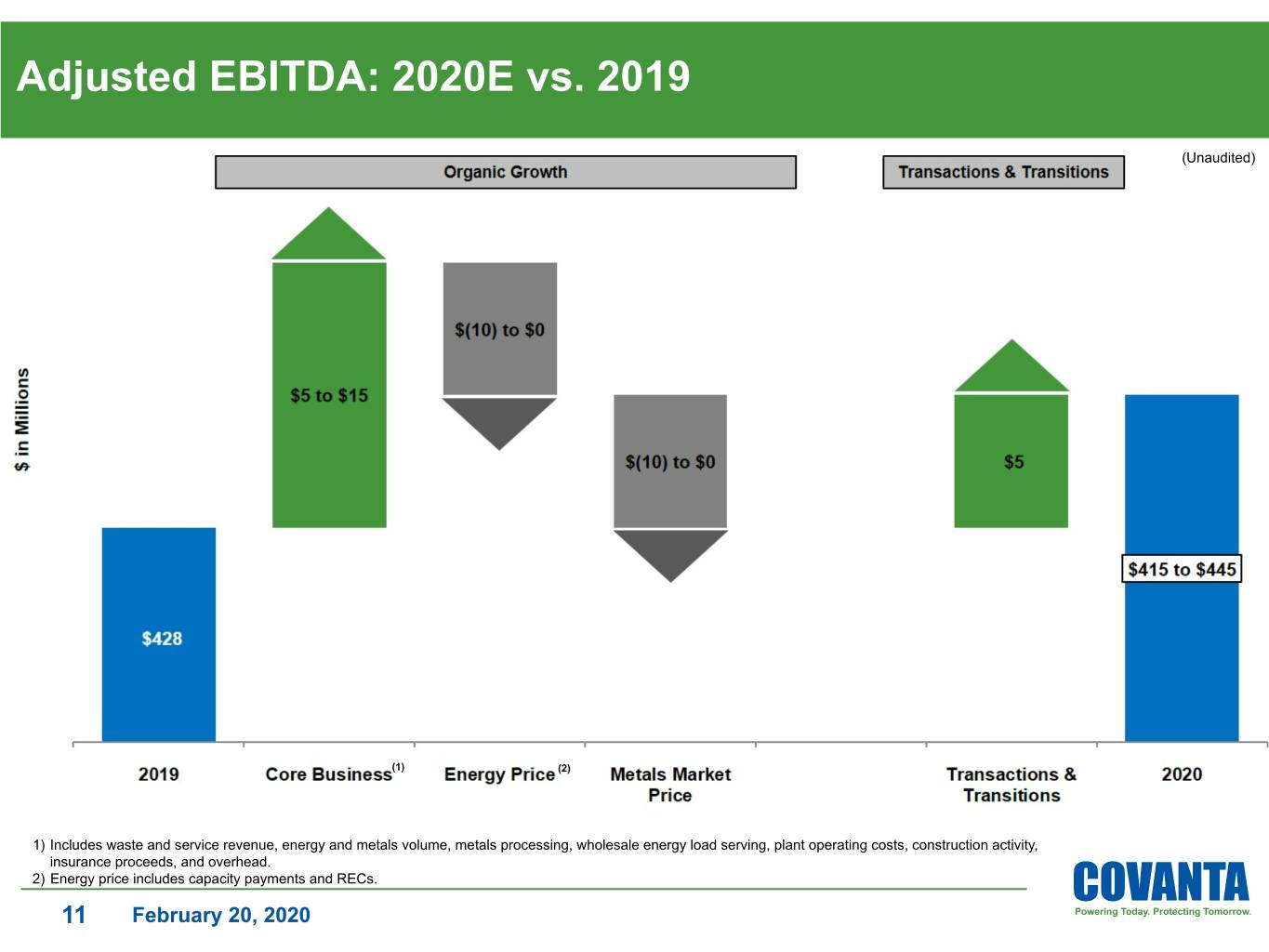
Adjusted EBITDA: 2020E vs. 2019 (Unaudited) (1) (2) 1) Includes waste and service revenue, energy and metals volume, metals processing, wholesale energy load serving, plant operating costs, construction activity, insurance proceeds, and overhead. 2) Energy price includes capacity payments and RECs. 11 February 20, 2020

Free Cash Flow: 2020E vs. 2019 (Unaudited) (1) 1) Includes capital type expenditures at client owned facilities. 12 February 20, 2020

Appendix 13 February 20, 2020

Waste Update (Unaudited) • 2019 revenue drivers vs. 2018: (in millions, except price) 2019A 2018A 2020E ▪ Same store EfW tip fee revenue: Waste & Service Revenue: ◦ Price up $31 million (5%) EfW Tip Fees $638 $624 $655 - $675 ◦ Volume lower by $2 million ◦ EfW profiled waste revenue grew by 11% EfW Service Fees 466 424 470 - 480 (excluding divestitures) Environmental Services 140 141 140 ▪ Other revenue growth drivers: Municipal Services 231 207 240 - 245 ◦ Service fees: Palm Beach Other 34 38 30 ◦ Municipal services: Manhattan MTS ramp Intercompany (116) (107) (120) Total $1,393 $1,327 $1,415 - $1,450 • Trends and outlook: (1) ▪ 2020 same store EfW tip fee price growth of ~4% EfW Tons: ▪ 2020 EfW profiled waste to grow in high single digits Tip Fee Contracted 8.8 8.9 8.7 - 8.9 Tip Fee Uncontracted 2.0 2.1 2.0 Service Fee 10.7 9.5 10.6 - 10.7 Total 21.5 20.5 21.3 - 21.6 EfW Tip Fee Revenue/Ton: Contracted 53.69 52.20 Uncontracted 82.61 75.97 Average Tip Fee 59.08 56.70 $61 - $62 1) Excludes liquid waste. 14 February 20, 2020

Energy Update (Unaudited) • 2019 revenue drivers vs. 2018: (in millions, except price) 2019A 2018A 2020E ▪ Same store EfW energy revenue: Energy Revenue: ◦ Price down $9 million Energy Sales $273 $291 $255 - $275 ◦ Volume down $7 million due to planned turbine outages at multiple large tip fee facilities Capacity 44 52 40 ◦ Wholesale energy load serving added $12 million Other (1) 12 - 45 Total $329 $343 $340 - $360 • Trends and outlook: MWh Sold: ▪ Volumes to improve by ~3% Contracted 2.1 2.1 2.1 ▪ Energy prices remain muted (2) ▪ Hedge activity: Hedged 3.0 3.1 3.3 ◦ Only ~1.1 million MWh exposed in 2020 Market 1.3 1.3 1.0 - 1.2 ◦ 1.5 million MWh already hedged for 2021 Total 6.4 6.5 6.4 - 6.6 ◦ Incremental 3-year wholesale load serving Revenue per MWh: (3) procured in early 2020 ▪ No meaningful tip fee plant contract transitions until Contracted $65.80 $66.59 $65 after 2024 Hedged (2) $34.29 $32.88 $32 Market $26.31 $37.12 $16 - $28 Average $42.81 $44.68 $40 - $42 1) Primarily components of wholesale energy load serving revenue not included in Energy Sales line, such as transmission and ancillaries and for 2020, RECs sold bundled with energy. 2) Hedged MWhs and revenue includes hedge from wholesale energy load serving. 3) Excludes capacity and other energy revenue. 15 February 20, 2020
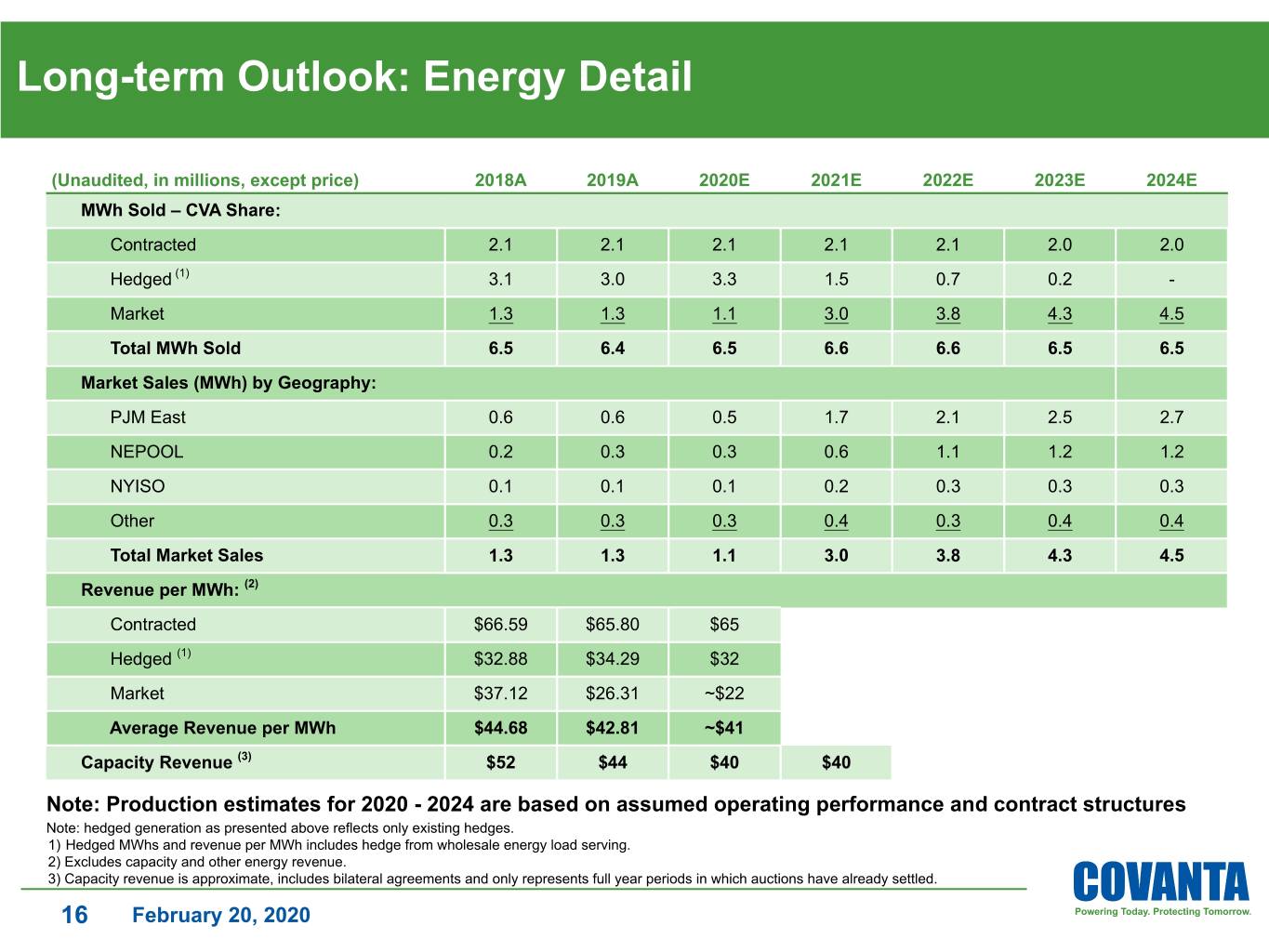
Long-term Outlook: Energy Detail (Unaudited, in millions, except price) 2018A 2019A 2020E 2021E 2022E 2023E 2024E MWh Sold – CVA Share: Contracted 2.1 2.1 2.1 2.1 2.1 2.0 2.0 Hedged (1) 3.1 3.0 3.3 1.5 0.7 0.2 - Market 1.3 1.3 1.1 3.0 3.8 4.3 4.5 Total MWh Sold 6.5 6.4 6.5 6.6 6.6 6.5 6.5 Market Sales (MWh) by Geography: PJM East 0.6 0.6 0.5 1.7 2.1 2.5 2.7 NEPOOL 0.2 0.3 0.3 0.6 1.1 1.2 1.2 NYISO 0.1 0.1 0.1 0.2 0.3 0.3 0.3 Other 0.3 0.3 0.3 0.4 0.3 0.4 0.4 Total Market Sales 1.3 1.3 1.1 3.0 3.8 4.3 4.5 Revenue per MWh: (2) Contracted $66.59 $65.80 $65 Hedged (1) $32.88 $34.29 $32 Market $37.12 $26.31 ~$22 Average Revenue per MWh $44.68 $42.81 ~$41 Capacity Revenue (3) $52 $44 $40 $40 Note: Production estimates for 2020 - 2024 are based on assumed operating performance and contract structures Note: hedged generation as presented above reflects only existing hedges. 1) Hedged MWhs and revenue per MWh includes hedge from wholesale energy load serving. 2) Excludes capacity and other energy revenue. 3) Capacity revenue is approximate, includes bilateral agreements and only represents full year periods in which auctions have already settled. 16 February 20, 2020

Recycled Metals Update (Unaudited) • 2019 revenue drivers vs. 2018: ($ in millions, except price; tons in thousands) 2019A 2018A 2020E ▪ Ferrous: Metals Revenue: ◦ Realized pricing down $17 million (29%) on lower HMS Ferrous $46 $58 $35 - $45 ◦ Same store volume up $4 million Non-Ferrous 40 37 40 - 50 ▪ Non-ferrous: ◦ Realized pricing up $1 million on improved mix Total $86 $95 $75 - $95 of higher value fractions Tons Recovered: ◦ Same store volume up $1 million Ferrous 424 424 430 - 440 • Trends and outlook: Non-Ferrous 51 49 50 - 55 ▪ HMS index at $233 per ton in February Tons Sold: ▪ Old Cast index at $0.39 per pound in February Ferrous 370 333 380 - 390 ▪ Improved non-ferrous mix in 2020 helps offset weakness in Old Cast index Non-Ferrous 34 31 35 - 40 ▪ TAPS currently in initial start-up, expected to ramp Revenue per Ton Sold: up over the course of 2020 Ferrous $123 $173 $85 - $115 Non-Ferrous $1,184 $1,218 $1,100 - $1,200 Average HMS index price (1) $252 $328 $200 - $250 Average Old Cast Aluminum (2) $0.42 $0.57 ~$0.36 1) 2019 and 2018 average #1 Heavy Melt Steel composite index ($ / gross ton) as published by American Metal Market. 2) 2019 and 2018 average Old Cast Aluminum Scrap ($ / pound) calculated using the high price as published by American Metal Market. 17 February 20, 2020

Maintenance and Operating Expenses (Unaudited) • 2019 drivers vs. 2018: (in millions) 2019A 2018A 2020E ▪ Total EfW maintenance spend lower by $9 million Plant Maintenance Expense: ▪ Acquisition of Palm Beach contracts was primary EfW $299 $290 $290 - $300 driver of increased maintenance expense Other 9 9 ▪ Higher other plant operating expense related to Palm Beach, Manhattan MTS and wholesale energy Total $308 $299 load serving Maintenance Capex: • Trends and outlook: EfW $96 $114 $140 - $150 ▪ 2020 EfW maintenance spend of $430 - $450 million Other 10 28 10 ◦ Includes ~$20 million for new baghouse at Total $106 $142 $150 - $160 SEMASS ◦ Enables continuation of record operating performance Total EfW Maintenance Spend $395 $404 $430 - $450 ▪ Other plant operating expense to increase reflecting growth in Municipal Services, metals and wholesale Other Plant Operating Expense: energy load serving EfW $729 $698 Other 333 325 Total $1,063 $1,023 Other Operating Expense $64 $65 18 February 20, 2020

Non-GAAP Reconciliation: Adjusted EBITDA Q4 Full Year (Unaudited, in millions) 2019 2018 2019 2018 Net Income $12 $9 $10 $152 Depreciation and amortization expense 56 56 221 218 Interest expense 35 34 143 145 Income tax (benefit) expense (1) 5 (7) (29) Impairment charges (1) — 2 86 Accretion expense — — 2 2 Severance and reorganization costs 2 — 13 5 Stock-based compensation expense 5 6 25 24 Loss (gain) on asset sales 1 (1) 4 1 Capital type expenditures at client owned facilities (1) 6 9 34 37 Net gain on sale of business and investments — — (49) (217) Loss on extinguishment of debt — 12 — 15 Business development and transaction costs — (1) 2 3 Property insurance recoveries, net — (11) — (18) Adjustments to reflect Adjusted EBITDA from unconsolidated investments (2) 7 7 25 23 Other 3 7 3 10 Adjusted EBITDA $125 $132 $428 $457 1) Adjustment for impact of adoption of FASB ASC 853 – Service Concession Arrangements. 2) Adjustment beginning in 2018 to equity in income from unconsolidated investments to adjust for the proportional impact of depreciation & amortization, interest expense, and taxes at the unconsolidated subsidiary (Proportional Adjusted EBITDA). 19 February 20, 2020

Non-GAAP Reconciliation: Adjusted EBITDA and Free Cash Flow Q4 Full Year Full Year (Unaudited, in millions) 2019 2018 2019 2018 Estimated 2020 Adjusted EBITDA $125 $132 $428 $457 $415 - $445 Cash paid for interest, net of capitalized interest (29) (21) (152) (136) (140) Cash paid for taxes, net — — (5) (2) (5) Capital type expenditures at client owned facilities (1) (6) (9) (34) (37) (35) Equity in net income from unconsolidated investments (2) (3) (6) (6) (5) - (10) Adjustments to reflect Adjusted EBITDA from unconsolidated investments (2) (7) (7) (25) (23) (20) - (25) Dividends from unconsolidated investments 4 12 9 13 5 - 10 Adjustment for working capital and other 29 (13) 11 (28) 40 - 60 Net cash provided by operating activities $114 $91 $226 $238 $260 - $290 Changes in restricted funds - operating (3) 2 (3) 20 4 - Maintenance capital expenditures (25) (47) (106) (142) (150 - 160) Free Cash Flow $91 $41 $140 $100 $100 - $140 1) Adjustment for impact of adoption of FASB ASC 853 – Service Concession Arrangements. 2) Adjustment beginning in 2018 to reconcile equity in income from unconsolidated investments to proportional Adjusted EBITDA. 3) Adjustment for the impact of the adoption of ASU 2016-18 effective January 1, 2018. As a result of adoption, the statement of cash flows explains the change during the period in the total of cash, cash equivalents, and amounts generally described as restricted cash or restricted cash equivalents. Therefore, changes in restricted funds are eliminated in arriving at net cash, cash equivalents, and restricted funds provided by operating activities. 20 February 20, 2020

Non-GAAP Financial Measures Free Cash Flow Free Cash Flow is defined as cash flow provided by operating activities, plus changes in restricted funds - operating, less maintenance capital expenditures, which are capital expenditures primarily to maintain our existing facilities. We use the non-GAAP measure of Free Cash Flow as a criteria of liquidity and for performance-based components of employee compensation. We use Free Cash Flow as a measure of liquidity to determine amounts we can reinvest in our core businesses, such as amounts available to make acquisitions, invest in construction of new projects, make principal payments on debt, or amounts we can return to our stockholders through dividends and/or stock repurchases. In order to provide a meaningful basis for comparison, we are providing information with respect to our Free Cash Flow for the year ended and three months ended December 31, 2019 and 2018 reconciled for each such period to cash flow provided by operating activities, which we believe to be the most directly comparable measure under GAAP. Adjusted EBITDA We use Adjusted EBITDA to provide additional ways of viewing aspects of operations that, when viewed with the GAAP results provide a more complete understanding of our core business. As we define it, Adjusted EBITDA represents earnings before interest, taxes, depreciation and amortization, as adjusted for additional items subtracted from or added to net income including the effects of impairment losses, gains or losses on sales, dispositions or retirements of assets, adjustments to reflect the Adjusted EBITDA from our unconsolidated investments, adjustments to exclude significant unusual or non-recurring items that are not directly related to our operating performance plus adjustments to capital type expenses for our service fee facilities in line with our credit agreements. We adjust for these items in our Adjusted EBITDA as our management believes that these items would distort their ability to efficiently view and assess our core operating trends. As larger parts of our business are conducted through unconsolidated investments, we adjust EBITDA for our proportionate share of the entity's depreciation and amortization, interest expense, tax expense and other adjustments to exclude significant unusual or non-recurring items that are not directly related to the entity's operating performance. in order to improve comparability to the Adjusted EBITDA of our wholly owned entities. We do not have control, nor have any legal claim to the portion of our unconsolidated investees' revenues and expenses allocable to our joint venture partners. As we do not control, but do exercise significant influence, we account for these unconsolidated investments in accordance with the equity method of accounting. Net income (losses) from these investments are reflected within our consolidated statements of operations in Equity in net income from unconsolidated investments. In order to provide a meaningful basis for comparison, we are providing information with respect to our Adjusted EBITDA for the year ended and three months ended December 31, 2019 and 2018, reconciled for each such period to net income and cash flow provided by operating activities, which are believed to be the most directly comparable measures under GAAP. Our projections of the proportional contribution of our interests in the Joint Venture to our Adjusted EBITDA and Free Cash Flow are not based on GAAP net income/loss or Cash flow provided by operating activities, respectively, and are anticipated to be adjusted to exclude the effects of events or circumstances in 2020 that are not representative or indicative of our results of operations and that are not currently determinable. Due to the uncertainty of the likelihood, amount and timing of any such adjusting items, we do not have information available to provide a quantitative reconciliation of projected net income/loss to an Adjusted EBITDA projection. 21 February 20, 2020
